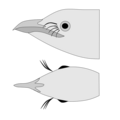Bristled grassbird facts for kids
Quick facts for kids Bristled grassbird |
|
|---|---|
 |
|
| Conservation status | |
| Scientific classification | |
| Genus: |
Schoenicola
|
| Species: |
striatus
|
| Synonyms | |
|
|
The bristled grassbird (Schoenicola striatus) is a small passerine bird. This means it's a type of bird that perches. It belongs to the Schoenicola genus. People also call it the bristled grass warbler.
This bird lives only in the Indian subcontinent. You can find it in places like Bangladesh, India, Nepal, and Pakistan. Bristled grassbirds love to hide in tall, thick grasslands. They often live in marshy areas. These habitats are sadly shrinking due to human activities. Scientists used to think these birds stayed in one place. Now, they believe some might migrate. They move south and east in India during winter. Then they return to their breeding areas in the northern plains. These plains are south of the Himalayas.
Contents
What Does the Bristled Grassbird Look Like?
This warbler is a fairly large bird. It has a brownish color. You can see broad, dark streaks on its head and back feathers. Sometimes, it might even look like a common babbler. Its tail feathers have white tips. The main part of the tail feathers is dark.
The bristled grassbird has a strong beak. Its legs are brown. The beak is black, with a bluish-grey tip on the lower part. It has a pale stripe above its eye, called a supercilium. Its belly is light and plain.
Special Features of the Bristled Grassbird
This bird has a unique feature. It has a bare patch of skin in front of its eyes. This area is called the lores. On this skin, there are five stiff bristles. These bristles point forward. The bare skin is flexible. Scientists think these bristles protect the bird's eyes. They might act like a visor. This helps when the bird moves through dense, rough grass.
The feathers on its chest are stiff. Some birds have dark tips on these feathers. This makes it look like they are wearing a necklace. Male and female bristled grassbirds look very similar.
Where Do Bristled Grassbirds Live?
Bristled grassbirds live in tall, grassy marshlands. Their main home is in the northern part of the Indian Subcontinent. They used to be common in many areas. These included Gujarat, Andhra Pradesh, West Bengal, and Orissa. They were also found in Lahore, Bangladesh, and Nepal.
Sadly, their homes are disappearing. Grasslands and marshlands are being destroyed. This puts the bristled grassbird at risk. Scientists once thought these birds stayed put. They believed their movements depended on the rains. Now, they think the birds might migrate. They breed along river plains south of the Himalayas. Then they spend winter further east and south in India.
How Do Bristled Grassbirds Behave?
Bristled grassbirds are very good at hiding. It's hard to spot them. You might see one briefly on top of a grass clump. But then it quickly dives back down. They usually stay hidden inside the grass. There, they look for insects to eat.
Male birds perform a special display. They rise about a meter (three feet) above the grass. They fly in a zig-zag pattern. Then they float back down like a parachute. They also make a call while flying. It sounds like a rising and falling chwee-chew.
Nesting and Eggs
The breeding season for these birds is from May to September. They build a nest that looks like a ball of grass. It has an opening at the top. They place the nest near the bottom of a grass clump.
A female bristled grassbird usually lays four or five eggs. Scientists believe only the female sits on the eggs. The eggs are white. They have small purplish-red speckles.
Gallery




